American Sabbatical 57: 11/28/96
Vino Baja
11/28.. Baja Vino.
On Friday Graham was back in harness as an Irish immigrant, b’gorrah, and we took the kids off for
a tour to give Bonny a break. The beach in front of the Grand
Baja is a steep cobblestone, sloping into a strip of coarse sand
at low tide, not a very playful place, so when the road south
skirted a true sand beach we pulled over to play by the waters.
You may remember that I made a pledge with Jim Torbert at the
beginning of this adventure. We jumped into the brine at Popham
Beach in August, and both promised to immerse ourselves on the
opposite sides, he in Spain, me in California. Well, folks, I
reneged. I'd had visions of tropical seas under sweltering skies.
This Pacific surf is strictly wetsuit stuff with a stiff breeze
bending the fanpalms. Yes, I could have been bold, but I did a
few laps in the hotel pool and then sat in the Jacuzzi under a
Baja moon. Does that count?
The Mexican propensity to decorate with film plastic extends to
the beach. There is litter everywhere we went in Mexico, and the
old saw about a poor people wasting not obviously predated the
plastic revolution. Adding to the charm were the horses for hire,
an almost universal opportunity in Baja, whose road apples dotted
the sands. The kids went riding on some flea-bitten nags, with
a colt gambolling behind and a woman guide managing the show,
while we tootled along the foamline with the shorebirds. There
were half a dozen different striders twiddling their legs up and
back with the surges, among which were an entirely unfamiliar
crested gull. I was amused that one of these birds looked disheveled
and hunched with its feathers all ruffled up, and it was berating
the other four of its kind with a fishwife’s nagging. They were
smooth, upright, and aloof. There’s one in every bunch.
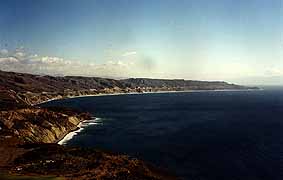
Bay of Ensenada
|
John led on to Ensenada, with the Owl in train. The road along
the headlands rose up to 1000 feet of dusty chaparral with another
Moorish fantasy palace in lurid pinks and lavenders perched on
the outer brink. We swung off down a dirt track that plunged in
switchbacks down to a campground. The sites were nestled under
olive trees in the glaring dazzle, and the view across Encenada
Bay was stunning. Bold umber bluffs making a grand sweep around
for 30 miles. All the way to La Bufadora, our destination. |
But first we had to navigate through the boomtown of Ensenada.
We were told that this sprawling burg has sprung out of a sleepy
crossroads in recent years thanks to the influx of gringo dollars,
but it looked as shabby and half-plastered as anywhere we’d seen.
It’s hard to tell which partial shells are once-was, will-be,
or might-have been. There were workingmen laboring in desultory
among the skeletons. The newest things in town were spanking-bright
1996 VW bugs in a dealer’s lot. They’re still making Beetles here,
and you can buy new engines for almost any vintage VW, which is
why the roads look like 1964. Most of the fuming, unmuffled vehicles
were decades old, however, and looked like applicants for a demolition
derby. The drivers acted the same. Trying to keep John’s zigging
van in sight and not get side-swiped by a kamikaze compadre left
me babbling in tongues. And the signage shouted back at us: Tecate,
Corona, Dos Equis!
| We finally made it back to the Uno, after a stop for icecream,
the purpose of this wild-John chase, as it turned out. The coast
road had occasional speedbumps, and at each there was a line of
stalls selling pickled peppers, bagged nuts, and other local produce.
Maybe we should petition DOT for speedbumps on Maine’s Route 1,
for the shrimp and blueberry peddlers. |
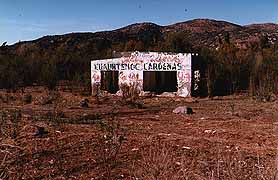
Roadside Attraction
|
We were in a line of California rec vehicles which all turned
off for La Bufadora: The Blowhole. The byroad passed between dusty
palms and across agricultural flats skirting the south side of
Ensenada Bay, mostly barren plowed turf in this season, but with
occasional green acres of northern vegetables. Peas in November!
Then the way rose up with the bounding cliffs, clothed in scrub
trees, and then chaparral. Looking back, the shabby shore we’d
wended around looked wild and romantic from afar. Cresting the
final rise on this rugged peninsula we skidded down into the maw
of a tourista trap: a narrow alleyway of gaudy stalls crowded
with gawkers and hawkers. Park here: 2 dols. We inched along through
the milling press until it became obvious that there was no public
parking, or it had all been pre-empted by free enterprise.
We were hardly out of the buggies before extruded snakes of sugared
fried-dough were being thrust into our faces. Empty your pockets
the eyes said. And the opportunities were rife. Nobody does kitsch
as well as the Mexicans, and this streetmart had something of
everything for sale. Lurid pottery, painted carvings, wild fabrics,
mirrored monstrosities, beads and bells, shell gizmos, switchblades
and sunglasses, rubberized gewgaws, tacky postcards, Malasian
trinkets.. along with beautiful fabrics, wonderful terracottas,
and silver jewelry of all types, from serpents-and-skulls to intricate
filigrees. There must be a guild of silversellers here, restricted
to short dark Mexicans who have to wear traditional costumes.
Either that or the same elderly couple of peddlers arise spontaneously
wherever gringo tourists appear. On the horse beach an ageless
man in serape, low-crowned hat, and sandals appeared out of the
empty sands to offer us silverwork in a peddler’s case slung over
his shoulder. His female double made the same silent approach
in Puerto Nuevo, out of a blind side. Now in La Bufadora both
of them were working the crowd.
Jostled and hustled we wiggled through and climbed down a stonework
stairway to platforms overlooking a cove. Holiday-makers were
pressed up against the railings, and cries of delight echoed in
the cleft. Rolling surges were lifting long fronds of kelp as
they marched toward the rocks below us, and BOOF: an arc of foamy
spray burst up the cleft, spattering the onlookers. That was it:
a muffled explosion and a salt shower. If you wanted to use the
toilets, it cost 2 peso for toilet paper.
My good humor was immediately restored. The absurd monkey had
done it again. Herded eagerly to see a cosmic non-event, and was
willingly paying for tacky trinkets to memorialize the experience.
Mainers are much too shy. Just think of the possibilities at Pemaquid
or Cape Elizabeth for sombrero sellers and lobsterclaw art.
We bought Coronas and fried dough and a “bargain” or two, and
headed back to Puerto Nuevo. This time going through Ensenada
it was the streetcorner hour, and workingmen with tired faces
were bunched in conversation at curbsides. Bus-stops were full
of women in long dresses clutching stringbags, and craning for
a view of their bus. The sharpedged sun was dulling into red and
the ocean darkening to swallow it. We were sniffing van-fumes
up the coast road and thinking about leftovers.
When we got back to the Grand Baja, John’s friend Tim had arrived
on his BMW, and we were soon up to our elbows in turkey and sweet
potatoes. After another dinner that couldn’t be beat, it sure
is sweet to float in a Jacuzzi on a November night under Mexican
stars.
We didn’t want to overstay our welcome with these working folks,
so we thanked them for a splendid sojourn, and made an early getaway
on Saturday, intending to circle round through Ensenada, up to
Tecate on the border, and then back to San Diego. Our caravan
now consisted of one hippy van, one masked Festiva, and one luxury
motorcycle, trading lead. Leaving the gold coast on Rt.3, we quickly
climbed out of the condo boom and into hardtime hill country.
We were casually waved through an army checkpoint by young men
with automatic weapons, and noticed there was more political graffiti
on the roadside boulders than along the shore. The urge to decorate
rocks with spraycan calligraphy must be overwhelming in Mexico,
to judge by its abundance. Up Rt.3 the only other abundance was
prickly-pears. Plots of prickly-pears in dooryards and on hillsides,
next to cinderblock bungalows. Both the flowers and the pads of
these comical cacti are edible, but it seems strange to grow these
hostile fruits in rows, like cabbages.
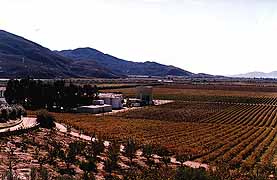
Vinyard View
|
Over the first range of hills we came into a desiccated valley
with rows of withered grape vines marching across the sand. But
this soon changed into healthier irrigated stock, and we were
surrounded by the vinyards of the Guadalupe Valley, producer of
90% of Mexico’s wine. Time for a wine tour. We pulled up to the
modern facilities of the Domecq Winery, in whose courtyard six
8-foot tall pottery vats, once used for winemaking, have been
converted into a gushing fountain, and I stood and drew the view,
while the party, well, partied. (They took the tour, followed
by the tasting.) |
Afterwards we all crossed the road (like chickens), and went up
the long drive between olive trees and vinyard rows to the Cetti
Winery. We’d been told by Graham to ask the way to the terraces
by the bullring, and to go there to picnic. Our directions took
us around and through the stainless industrial plant and up a
manicured gravel road to a magnificent setting. Here in the middle
of a seared Mexican valley there’s a Mediterranean hideaway. From
our lofty perch on bright sienna tile platforms, under a vast
shadecloth-on-painted-steel ramada, we looked out over hundreds
of acres of productive vines. Immediately to our right was a sparkling
clean bullring, while behind us were shady groves of olive and
almond trees. A steady breeze brushed against us as the 70 degree
sunshine soaked in deep. We feasted on fruits and nuts and cheese
and salads, and felt like kings on the mountain.
(Memo #50)
Nov. 30 - VINO BAJA
Who? Domec family and others
What? vineyards
Where? Baja, Mexico
When? last twenty years
How? planted vines, built bottling plants
Topics: winemaking, wineries.
Questions: How is wine produced? Is wine an important product
of Mexico? What spinoff industries are associated with winemaking? |
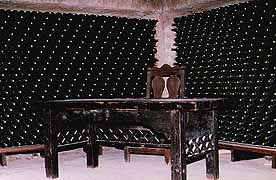
Vino
|
We spent Thanksgiving in the Baja and cooked our turkey on an
outside grill with fixings made on a campstove. Our hosts were
a San Diego couple staying in the Baja to perform as extras on
the Titanic movie being filmed there. A huge model of the Titanic
- complete with hydraulic lifts to raise the stern to a perpendicular
position - stands on the coast of Baja just off the coastal highway.
It will be hilarious if any goofs allow the movie’s viewers to
see palm trees or a Mexican village off to the side. Our hosts
had many stories to tell about being in their first movie.
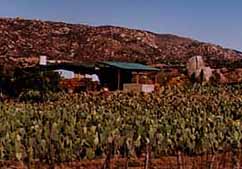
Cactus Farm
|
The Saturday after Thanksgiving we set off to drive inland, see
wineries, and return to San Diego through the Baja’s Guadalupe
valley to beat the holiday rush the next day. The drive inland
took us through small villages and stark hills. At several places
we saw cactus farms with the plants in oddlooking orderly rows
(!). Dry rocky hills with desert plants ranged on either side. |
Two wineries surrounded by acres of grape plants stand across
the road from each other in the valley (Domecq and Cetto). Together
they produce 90% of Mexico’s wines. The wineries are becoming
increasingly popular tourist attractions, with tours throughout
the day. There are few other tourist facilities, however, in the
valley. We decided to tour Domecq. A broad drive lead straight
through rows of grapes to the huge buildings set on a low hill.
Directly in front of us was a fountain made out of four or five
huge ceramic pots that were used in the past to store wine. The
tours start from a large room where wines can be sampled and bought.
The tour before us was imbibing with pleasure.
| Domecq has been producing wine for three hundred years and has
wineries in Argentina, South Africa, and Mexico. Two years ago
a British corporation took over. Wine is grown in only 2 valleys
in Mexico (only in the Baja) and processed in 6 wineries. Domecq
produces a variety of wines (cabernet, zinfandel, ruby, chemin
blanc, chardonnay, chardonnay blanc, palomina, etc) as well as
13 brandies. The brandies are processed in other places. 40% of
Mexico’s wine is exported. |
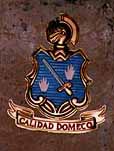
Seal of Domecq
|
Domecq has been in the valley since 1972. It produces 18 million
liters of wine a year. This winery employs 50 people in the winery
itself and hires approximately 150 pickers at harvest time. It
processes its own grapes plus others from fields near Mexicali
(from contracts with independent growers). Because all grapes
are pressed the day they’re picked (preferably within 4 hours),
the Mexicali grapes are picked at night and trucked immediately
to Domecq. Grape vines take 2-3 years to produce quality grapes.
The key problems for the grower are grasshoppers, fruit flies,
and fungus. The 1996 harvest was apparently small. (Apologies
to wine aficionados for any inaccuracies.)
Our guide took us through the adjacent bottling plant that could
process 90 bottles of wine a minute or 2500 cases a day. A row
of huge stainless steel vats could hold 25,000 liters of wine
apiece for bottling. Then we followed a corridor to a wide staircase
and descended to the wine cellars. They were picture perfect.
A huge, low- ceilinged whitewashed space dimly lit with arched
bays along one side filled with stacked bottles (12,000 per section).
Bottles have to be stored on their sides so the wine is in contact
with the cork. 3 rows of barrels filled the center of the space
(75 in
all?) The cellars are kept at 14 degrees Celsius all year. Wine
for 334,000 bottles is stored here for six months to a year. The
key decisionmaker in a winery is the winemaster who decides when
a vintage is ready for bottling and market. The wine is stored
in barrels made of French Oak and American White oak. A Napa Valley
(California) cooperage produces them.
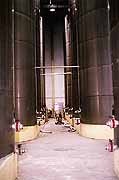
Vats
|
We left the main cellar and followed a broad corridor past a shrine
dedicated to the Virgin of Guadalupe. Then upstairs to another
huge storage room full of huge barrels of Yugoslav oak. This room
is kept at a steady 14-17 degrees Celsius. |
A hundred yards separated this building from the other. The processing
plant looks much like any industrial building of metal with cement
floors and complicated pipes and gauges everywhere. During the
harvest trucks can be pulled up to a line of outside bays where
the grapes are conveyed into 20 ton crushers. The grape paste
is sent by pipes into the building. Grapes with skins kept in
become red wines. For whites, the skins are removed. The grape
byproduct not used for wines or brandies becomes fertilizer and
cowfeed. Bland wines are pressed twice, other fermented products
are pressed 4-12 times. The crushed grapes are stored at 14-17
degree Celsius in 500 liter tanks. This large industrial building
was full of these huge stainless tanks. We sat near a tank with
open “hatch” near the bottom just big enough for a person to squeeze
through that we could look into. Each tank is meticulously cleaned
with antibacterial soap after each use. The cleaners must go in
through the small opening (no way, I thought!). After the appropriate
pressings, the wine goes to the other building. It is an efficient,
modern industrial facility. I asked about research and was told
the wineries have a program to increase production. Trade schools
have not yet been used for training.
| After the tour we had sips of a variety of wonderful wines and
bought two bottles as Christmas present (only $10 apiece). We
then drove to a low hill overlooking Cetto Winery where the vintners
have created a wonderful picnic area. A series of cement terraces
with rocks walls are shaded by wooden ramadas (arbors) and surrounded
by rose gardens. A spotless bullring lay just downhill. We imagined
a colorful bullfight and barbecue occurring after harvest. |
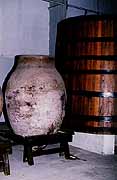
Old and New
|
Winemaking is an intricate and skilled process. Domecq and Cetto
have huge modern facilities that will transform the valley and
provide work in many associated industries. There is real potential
for tourist facilities and education programs. I’d love to find
out where the bottles are produced and the labels. What metal
shop produced the hoops for the barrels? Is there an oak forest
maintained by winemakers? Where is the larger machinery for pressing
and bottling manufactured? Where are the grape vines from and
have they been genetically altered? Where is the wood from for
the vine row supports in the field ? Who cuts it? Does the vineyard
have carpenters? Are pesticides used?
11/29.. Baja continued.
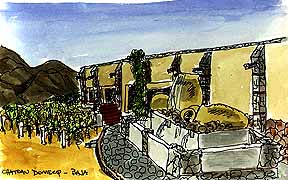
Baja Vino
(Bryce)
|
This really was the far corner of our journey. It has been snowing and freezing in Maine already, and that
world is buttoned up, but here we sat in the lee of some Mexican
stonework, still totally open to the kisses of heaven.
|
And it was time to turn homeward. The rest of our samba to San
Diego was uneventful. The austere mountains of central Baja with
their desert shrubs and cactus would make a cowboy lonesome and
his horse unhappy, but the thickening chaparral near the border
must be a delight to a smuggler’s eye. We were waved through immigration
at Tacate without ado, and again were struck by the radical demarcation
between physical cultures. Tacate was a drab tin and cinderblock
town with men clotting on street corners and trash and graffiti
underfoot. Just across the DMZ the relative affluence was palpable,
and even the vegetation seemed lusher. The trash disappeared.
We joined a high-speed slalom of homing Californios between the
border mountains. Coasted through the Border Patrol check and
came out of the wilderness into civiliburbia beneath the radio
towers on Mt. Miquel. But nobody wanted to go home, it seems.
When we made a gas stop in LaMesa it was decided that we’d go
for pizza in Ocean Beach, all the way across the city to the north
shore, past the marine park. So we played chase-Tim through freeway
traffic, and followed the sun setting down to the water’s edge.
But, even after Italo-American therapy, the majority voted to
cruise OB rather than confront familiar reality. So we sniffed
around headshops and watched San Diego’s finest shakedown a streetkid
on the breakwater, then dragged ourselves out onto the dimly lit
pier. Shining crests of breakers curled out of the darkness and
rushed to their noisy ends underneath us, dying on the beach beyond.
But we were too weary to be exhilarated. The holiday was over.
We finally dragged ourselves to bed in Encanto.
| We have had lots of reasons to be thankful this year. For us a
cycle of bad times rose up and receded in ‘96, but there are other
waves on others’ beaches, and some folks are too close to the
edge. We’ve gotten a look at some places people run to, when they
run out of America, but you have to squint your eyes to call them
paradise. |
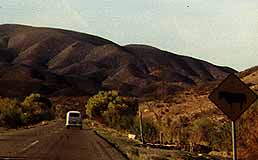
Mexican Escape
|









